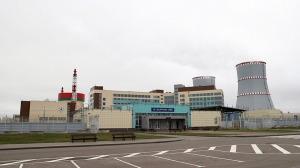Belarusian nuclear power plant's first unit's acceptance certificate signed

OSTROVETS DISTRICT, 10 June (BelTA) – An acceptance commission led by Deputy Prime Minister Yuri Nazarov has signed a certificate, which states the first unit of the Belarusian nuclear power plant has been accepted for commercial operation, BelTA has learned.
The commission's decision relies on positive conclusions of oversight bodies and the provisional commission of the Belarusian nuclear power plant as well as the first unit commercial operation license granted by the Emergencies Ministry.
The acceptance commission includes representatives of the Energy Ministry, the Emergencies Ministry, the State Standardization Committee of Belarus, the Architecture and Construction Ministry, the Natural Resources and Environmental Protection Ministry, the Healthcare Ministry, the Internal Affairs Ministry, the Grodno Oblast administration, the national energy company Belenergo, and representatives of the Russian companies ASE, Atomstroyexport, and Atomtechenergo. The relevant specialists and scientists have also contributed to the commission's work.
A large amount of work was done before the commercial operation stage. The readiness of the plant and equipment for handling the heat and electric output had to be checked. The necessary tests and trial runs were arranged. The personnel had to be trained.
At present the unit is operating at the nominal output capacity of the reactor unit. Since it was connected to the power grid, it has generated nearly 3 billion kWh of electricity.
The Russian generation III+ design AES-2006 was chosen for building the Belarusian nuclear power plant. It meets international requirements and recommendations of the International Atomic Energy Agency in addition to boasting increased safety parameters. As many as 36 construction companies have helped build the Belarusian nuclear power plant. The number of construction workers working at the site peaked at 8,500 people.
The Energy Ministry press service said: “In the years of implementation of the national nuclear energy program Belarus made serious steps on the way towards forming a system of nuclear and radiation safety and its crucial components, including the creation of the relevant legal base, the construction and operation of a protection and response system, personnel training, systematic interaction with leading international organizations. The construction of the Belarusian nuclear power plant is a massive project that drives the development of many branches of the economy, facilitates the large-scale introduction of modern technologies at production sector enterprises, secures the creation of new jobs, and creates additional capabilities for raising living standards.”













